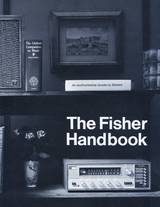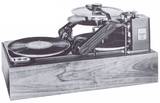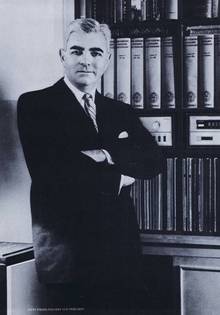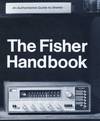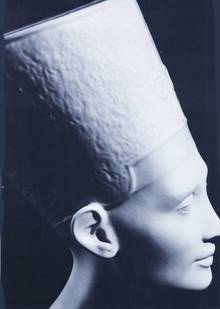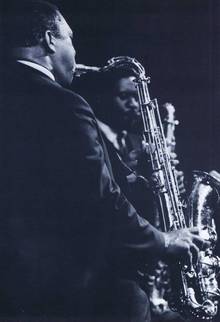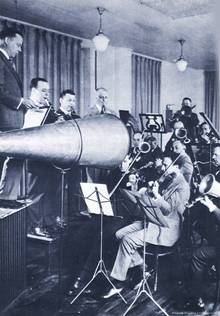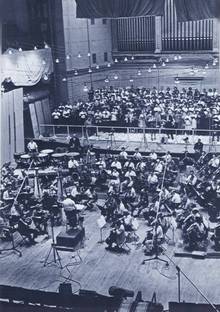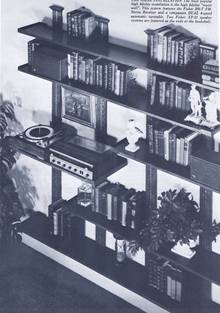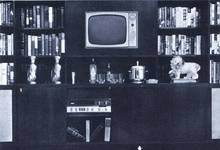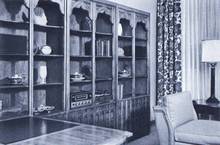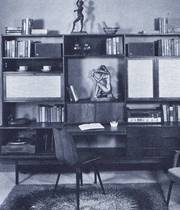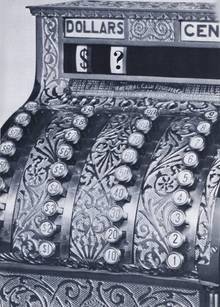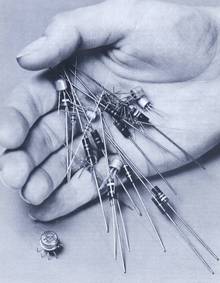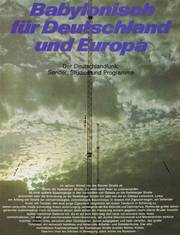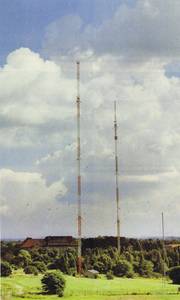1967 - Die erste uns vorliegende dickere Broschüre von Fisher mit den Produkten für 1968 - teilweise noch Röhrentechnik
Auch "The Fisher" hat es gemerkt, die modernen Hifi-Stereo Produkte sind erklärungsbedürftig und der Markt ist noch lange nicht reif, Hifi von allein zu kaufen. Die Interessenten, die überhaupt auf diesen Zug aufgesprungen waren oder gerade am Erkunden waren, brauchten Hilfe.
Diese schwarz-weiß Broschüre im amerikanischen B4 Format hat schon richtiges Geld gekostet, doch der gesamte amerikanische Markt stand offen und das waren nicht unerhebliche Möglichkeiten. Avery Fisher hatte sich den bisherigen Hifi-Markt mit nur ganz wenigen Mitbewerbern geteilt, die dort im oberen Bereich überhaupt etwas Vernünftiges anbieten konnten.
.
Einige Produkte sind verschwunden:
Es gibt keine Hifi-Bausätze mehr. Die propagierten StrataKits waren doch wohl nicht der Renner und wurden gestrichen. Der Superplattenspieler LINCOLN wurde zugunsten des Dual 1009 gestrichen. Auch der super tolle dicke Röhrenverstärker war ausgelaufen.
Dafür wurde das Geräte-Programm unterhalb von "Hifi "ergänzt. Zu der Zeit hatte ich (gr) Kontakt zu einigen Amerikanern, die ihren Wehrdienst hier in Deutschland ableisten "durften". Andere mussten damals nach Vietnam, das war gar nicht lustig. Dort war das verlangte Niveau der ersehnten Musikanlage im 100.- Dollar-Bereich. Und dafür gab es solche für uns merkwürdigen Paketanlagen, hier Musikcenter genannt.
Bei unserer Aufbereitung dieser Broschüren verändern sich natürlich die Referenzen auf die alten Seitenzahlen, sodaß diese hier nicht mehr dabei sind. Auch werden viele Bilder nicht mehr ganzseitig dargestellt. So wichtig sind die auch wieder nicht. Im folgenden Verzeichnis sind hilfsweise unsere Kapitelnummern vorangestellt.
.
Tabel of Contents - Das Inhaltsverzeichnis
Beginning with : A Word from Avery Fisher
.
- The Greatest Audio Instrument, By Ken Nelson
- The Nature of Sound, By Hans Fantel
- High Fidelity's Golden Decade, By Walter 0. Stanton
- What Can You Expect from Stereo? By Lee Wilcox
- Adding Music to the Room Scheme, By Sherman R. Emery
- How High the Hi-Fi Sights, By Ivan Berger
- Solid State Stereo, By Leonard Feldman
- The Long and Short of Short Wave, By Roland Gelatt
auf der nächsten Seite The Fisher Book 67/68 Teil II kommt dann : - The Stereo Mods, By Norman Eisenberg
- Speakers, Large, Small & In Between, By Bob Marx
- How to Judge Speaker Quality, By Larry Klein
- Room Acoustics, By Peter Sutheim and Larry Klein
- From Record Changer to Automatic Turntable, By Julian Gorski
- The Proper Storage and Handling of Records, By Charles A. Fish
- How To Buy a Tape Recorder, By Paul Edwards
auf der nächsten Seite The Fisher Book 67/68 Teil III kommt dann : - High Fid elity Terms: A Technical Glossary
- The Complete Stereo System
- The Stereo Receiver
- The Speaker System
- The Tuner
- The Amplifier
- Outstanding Features and Specifications of Fisher Components
- Exclusive Fisher Audio Accessories
- Who Owns A Fisher?
- Why Fisher Owners Keep On Being Fisher Owners
- Fisher Firsts
.
Herbst 1967 - A Word From Avery Fisher
The three previous editions . . .
.... have probably introduced more people to the basics of hi-fi and stereo than all other publications combined. And it was a thorough introduction.
But it came to our attention that a small, enthusiastic group of beginners had found an even more exhaustive source of information. They simply began to read every available magazine on high fidelity plus the hi-fi columns of the general magazines and newspapers-and kept at it for a year or two.
This we couldn't continue to observe without doing something about it. So we prepared this new Handbook.
We gathered together scores of copies of the audio and high fidelity magazines, read hundreds of articles and made a selection of those we believed would provide a comprehensive coverage of the entire subject.
Then we took one further step and condensed these articles to eliminate the more technical and detailed portions, while taking great care to preserve the essence of each. We were most pleased that each author concurred in our judgment. The result is an entirely new Handbook that covers just about everything you should know and may ever want to know about high fidelity components. We sincerely hope that you will have as much pleasure in reading this new Fisher Handbook as we had in creating it.
Herbst 1967 - Dies ist die 4. überarbeitete Ausgabe des "The Fisher Handbook"
Mr. Fisher schreibt in seinem Grußwort, daß man sich für diese Handbücher entschieden habe, nachdem bekannt wurde, daß sich zukünftige Hifi-Kunden über 2 Jahre lang in allen nur möglichen Hifi-Magazinen schlau machen "mußten", um "einen Fisher" zu kaufen.
Diese Arbeit wolle man ihnen hiermit abnehmen.
.
(1) The Greatest Audio Instrument (ist das Ohr)
By Ken Nelson
Every minute of the day you have with you a high-precision audio test instrument, one that has a basic, essential role in the art of audio. It can perform incredible feats of discrimination - but it also has certain weaknesses that must be recognized and allowed for.
This fantastic instrument is your hearing system.-It can do things no other instrument can do. Unless you use it properly and well, you will be severely handicapped in your attempts to build, judge, and improve audio systems.
We can consider first the ear's ability to hear small sounds. Most people undoubtedly think that electronic instruments, with their hold on the sub-microscopic, can far outdo the ear on this score. Not so. Readers are likely to know that sounds, striking the thin ear drum, cause the membrane to vibrate in step with them much as the diaphragm of a loudspeaker to produce sound. The ear drum's vibrations are passed on to a complex apparatus in the inner ear that converts them into electrical impulses, for the trip up nerve pathways to the brain.
One measure of a sound's strength, therefore, is the distance the ear drum vibrates in response to that sound.
But, you say, if the ear has such sensitivity to the tiniest rhythmic disturbance in the air, why aren't we flooded, confused, overwhelmed at every moment by a continuous roar of unrelated sounds? The ear hears only certain ones-generally the louder ones and those of higher frequencies. This capability of the ear is called masking. In masking, one sound does not merely obscure another: the second becomes actually inaudible. Masking is clearly nature's way of preventing us from going mad from the competition of simultaneous sounds. Interacting with masking is another characteristic of the ear, the "Fletcher-Munson effect" known to all professionals and advanced audio-fans. These two scientists of the ear demonstrated that the ear hears bass much less well, and highs somewhat less well, at low volumes than at high volumes. Put it another way: when you turn the volume down, the bass fades out much more than the middles do.
One of the important powers of the hearing system comes into play when you are judging an audio system. You can concentrate on a particular instrument or group of instruments, choosing, by an act of will, to exclude all the other sounds from the forefront of your attention. A conductor, of course, must have
this ability to a very high degree. He must be able to hear exactly what the oboe did during the last fortissimo passage-and the next time through it, judge the phrasing of the cello players! Piano tuners also develop this concentration highly, because they must listen to the relations among the very weak harmonics, or overtones of the notes struck, while ignoring the much louder fundamentals of the tones.
The audio experimenter has to use the same ability when judging an audio system. How good is the bass? He must concentrate on the double basses, bass tuba, or big drums long enough to determine how the bass quality compares with the standard, or with his long-ingrained knowledge of the recording. He never does two things at once-after finishing with the bass, he perhaps turns attention to the highs. A series of cymbal crashes, or snare drum, or top organ notes, give him clues to the handling of the highs. Now middles-do violins or woodwinds sound "honky"? And so on through all the important characteristics of the sound.
This concentration process is apparently one you learn, at least to some extent. If you find it hard at first, you are like most people. Conductor and piano tuner get their super-sharp powers only through long training. One way of leading into the process is simply by following a theme carried by instruments that you want to hear. This is similar to hearing a melody clearly, along with an accompaniment. By using this trick, plus conscious effort at concentration, you can learn to do it in a short time.
Finally, let us consider some characteristics of the ear as it relates to stereophonic reproduction. Foremost is the ability to tell the direction of the sound, another of the ear's super-tricks. We perceive direction, by comparing what happens at the right ear with what happens at the left. If a sound is off to the right, for instance, it reaches the right ear a little sooner and a little stronger than the left.
To locate a sound within one or two degrees, we have to sense which ear gets a sound first when the two are only about 6 microseconds apart (which is to say, six-millionths of a second). How the nerve system does this is still something of a mystery, because it takes many times as long for the impulses to travel up the nerves to the brain.
This is just one more of the many phenomena which make the ear the greatest audio instrument of them all!
Condensed from Audiofan St. Regis Publishing Company
(2) The Nature of Sound (ist die Live-Musik)
By Hans Fantel
It is all too easy, in discussing the principles of sound reproduction, to take it for granted-and therefore lose sight of-the first requirement for high fidelity; something to be faithful to. Sound, after all, is not only the end product of high fidelity, but the raw material as well. The central purpose of a hi-fi system can perhaps best be described as the accurate reproduction of that part of the infinitely various world of sound that is used for the creation of music.
Take, for example, the matter of tone color-also called timbre-which contributes so significantly to the texture of music. A cello and a trombone may both be playing the same musical note, but the listener can easily tell them apart. What accounts for this?
When the great German physicist H. L. F. Helmholtz first began to analyze sound some one hundred years ago, he discovered that what the listener hears from an instrument as a single musical note actually consists of many different tones.
There is, first of all, the basic pitch perceived by the ear-called the fundamental. But in addition to this fundamental tone, the musical note embodies a whole series of additional tones, called overtones or harmonics. These are multiples of the fundamental frequency (i.e., twice, three times, or four or more times the frequency of the basic note). Not all of these overtones are equally strong, nor do they have the same phase (time) relationship to the fundamental. Each musical instrument has its individual overtone pattern and it is this pattern that gives each instrument the characteristic tone color by which we identify it.
Now, since hi-fi components must reproduce this pattern accurately if the sound is to be faithful to the original, it can be seen that a wide-and uniform -range of frequency response is necessary. Suppose an oboe is playing a note with a basic frequency of 1500 Hz. Its overtones would be: 3000 Hz (1500 x 2), 4500 Hz (1500 x 3), 6000 Hz (1500 x 4), and so on. To do justice to the sound of the oboe, the system must reproduce these overtones in the exact strengths and phase relationships in which they occur in the original.
Even instruments such as the bass violine, the tuba, and the kettledrum - the lowest-pitched instruments in the orchestra - produce higher frequency overtones that give them their particular tonal flavors. This accounts for the seeming paradox that a sound system must have a frequency range up to at least 15,000 Hz in order to reproduce instruments whose basic pitch is in the lowest octaves of the musical range.
Another requirement for faithful reproduction of timbre is the absence of harmonic distortion. This type of distortion occurs when an electronic component, in effect, adds to the sound some overtones that were not contained in the original music. Such additions falsify the tone color because they alter the overtone pattern of the original.
Any discussion of the principles of sound must also include a brief explanation of its two fundamental attributes-pitch and loudness. These, together with harmonic structure, are the elementary physical realities of musical sound, the absolutes against which the performance of a high-fidelity system must be judged.
Sounds are fast-moving areas of high and low air pressure-created by the "pumping" action of a sound source such as a plucked string, the vibrating body of an instrument, or the resonant action of an enclosed air mass. The air adjacent to these vibrating elements is driven back and forth, thus forming a series of pressure peaks and nulls that are first sensed by the eardrum and are then passed on and perceived as sound by the brain.
The lowest sounds audible to the human ear (the roll of distant thunder, for instance) have a frequency of about 16 Hz. The lowest musical notes, such as the pedal notes of an organ, are in the vicinity of 30 Hz, although it is a rare musical note that falls below 50 Hz. A sound system with a bass response extending down to the 40- or 50-cycle range is therefore quite adequate for music reproduction.
The upper limit of human hearing varies with age. As a rule, only the young can hear frequencies above 20,000 Hz. The limit for adults usually lies around 16,000 Hz, declining with age (in most cases) to 10,000 cycles or less. No musical instrument has a basic pitch higher than about 5000 Hz. But music played on a radio or phonograph that is limited to a top frequency of 5000 Hz sounds stripped of tonal richness - and it is, for the overtones that lend each instrument its characteristic tone color fall mainly in the 8000 to 15,000 Hz frequency range. A frequency response that extends to at least 15,000 Hz is therefore essential if the reproduced sound is to bear any relation at all to the original.
In addition to pitch and timbre, each musical note also has a certain loudness. And this, of course, means that there is yet another basic requirement for high fidelity equipment; it must be able to render different loudness levels in natural proportions, doing equal justice to delicate pianissimi and to riotous orchestral outbursts.
To many people the notion of music running through a wire seems quite uncanny. Indeed, the transformation of physical energy (sound) into electrical energy-and back again-is a marvelous process, although it is a commonplace event that happens-to give only one example-every time we speak into a telephone. If you really understand the relationships between physical sound and its corresponding electrical and mechanical expressions, you have, essentially, the key to the mystery of audio reproduction.
Condensed from Stereo Hi Fi Directory. Copyright by Ziff-Davis Publishing Co.
(3) High Fidelity's Golden Decade (ein Schellack-Aufnahme)
By Walter 0. Stanton
President, institute of high fidelity, inc.
If you could go back half a century, you'd find record companies proclaiming the "concert hall realism" of their shellac discs. For many people, this claim did not distort the truth. The voice that came from that old "morning-glory" horn - ghost-like and distant - was probably as close as they would ever get to a concert hall. Besides, who really cared? Being able to hear Caruso's voice, on command, certainly beat pumping the player piano!
During the phonograph's first 60 years, new developments were widely spaced, and stood out in solitary grandeur. Among those lonely mileposts were the moves from acoustical to electric recording in the Twenties, from acoustical to electrical playback, and the replacement of wind-up, spring-driven turntables by electric motor-driven types. Against the background of such achievements, the beginnings of the high fidelity industry seem to have come about almost unnoticed . .. unnpticed, that is, except by those who knew, 25 years ago, that we stood on the threshold of genuinely superb sound reproduction in the home. True "concert hall realism" was more than an ad man's hyperbole.
After World War II, the high fidelity industry moved briskly forward. It established itself firmly with the emergence of a coterie of music listeners who really cared about superior reproduction. They cared enough to buy the industry's output in sufficient volume to give impetus to what had previously been nothing more than a hobby for the technically-minded. The producers of high fidelity products responded by continually improving their sound-reproducing equipment. That brings us to what can be termed, appropriately enough, the "Golden Decade" of high fidelity.
For an opener, think back 10 years: Try to remember the type of high fidelity equipment available then, and the quality of recorded music for the home. If you can recall it, you will be as impressed as we are with the state of developments today. Even the best informed hi-fi buff couldn't have anticipated today's superior sound from the listening-posts of 10 years ago. New developments have followed each other in rapid succession, and the pace of progress has steadily accelerated.
Consider stereophony. It seems hard to believe that the stereo disc has existed for less than 10 years, but commercially available stereo records did not appear in abundance until the fall of 1958. Experimental stereo discs did not precede them by more than a few months.
Transistorized circuits have given rise to new values in equipment and to new convenience for the user: The compact, combination component - the stereo-receiver - is easy to hook up, offers such applications as AM radio, FM, stereo FM, phono and tape inputs, and controls for all. The earlier tube unit was bulky and heat-producing; the solid-state unit with its tiny transistors does the same job, at the same or lower cost, with not nearly the bulk or heat. The transistor trend is a prime example of the continuing research and development that takes place to push what we consider the ideal to new levels of perfection.
Not all of the progress during the past ten years has been so obviously dramatic. Phonograph cartridges, for example, haven't changed very much in appearance-except that the stereo models are four-pronged at the output end instead of two-pronged. The audiophile may be excused if he did not notice that the moving mass of the cartridge - already minute - has diminished even more, and that its compliance (its ability to be moved by the record groove and return to rest) is very much greater. These accomplishments can quicken the heartbeat of an engineer who has been puzzling over how to achieve them, but they are not readily discernible to the eye of the cartridge buyer.
What do these improvements in cartridges mean in terms of sound? More definition in the high highs, silky-smooth highs, and a solid mid-to-low range. Anyone who hasn't replaced a cartridge in the past five years can do so with the confidence that greatly improved performance will result.
Improvement in record playing mechanisms has proceeded apace. Distortion factors stemming from variations in turntable speed have been whipped by continuing refinement. And such gross problems as rumble can only be detected by laboratory instruments in order to determine the degree of their inaudibility. Today, manufacturers turn from the problems that may have plagued them a decade ago and vie with each other in creating better convenience features for the user.
What's ahead? It's hard to say, except that additional progress will be made. For high fidelity sound reproduction is not a fixed point. To a manufacturer of such equipment, it's more a state of mind -striving for excellence. And as long as the will to do it better is present, ever higher fidelity will be the predictable result.
Condensed from Modern HiFi & Stereo Guide. Copyright by Maco Publishing Co., Inc.
.
(4) Herbst 1967 - What Can You Expect from Stereo?
By Lee Wilcox
"What am I supposed to hear?" is the anguished wail of far too many stereo owners. In fact, the stereo effect has gotten to be like the "Emperor's New Clothes" - if it's supposed to be there, who wants to admit he can't hear it?
Even though stereo equipment has been on the market for years, there are still many misconceptions and sometimes disappointments. FM stereo availability has increased the need for clearing up misunderstandings.
"Stereo" comes from the Greek word meaning "solid." Today, "stereo" is generally used to mean "three-dimensional." Stereo reproduction, then, is three-dimensional sound - more solid and thick than monaural reproduction. The emphasis should be on "more," for stereo is not the be - all and end - all of recorded sound.
Just as movies are not live theater and photographs are not the things they are pictures of, and television is steps removed from reality, so recorded sound is different from live sound. The goal of stereo sound engineering is to make recordings resemble real sound more closely.
A good stereo rendition of ping pong will have the ball "ping" here and "pong" there. A few years ago, if you wanted to be one up, you said, "Ah! Great separation." But this sensational approach to the stereo effect is palling fast.
You don't want to sit in the middle of the orchestra to hear Beethoven. He didn't write with that in mind, and your ears - not to mention your soul - aren't built to enjoy such a conglomeration of sounds. But you would like to be in a concert hall, and this is the effect that stereo can recreate, often to a surprising degree. The reason is almost, but not quite, obvious.
Since you hear with two ears, you hear, in a sense, two sounds - a left ear sound and a right ear sound. Even the slight distance between ears is distance enough for sound to be slightly modified. Sound travels relatively slowly - 1,087 feet a second. The slight time lag in reaching one of your ears is one of several ways you decide where sound comes from. It also helps to single out one sound from other sounds.
Stereo recreates the poly-sourceness of sound. If you were to compare a monaural to a stereo recording of cocktail party chatter, you would find significant differences.
The monaural version would tend to be indistinguishable babble; just noise. If you were present at the party, you would not find the babble all that indistinguishable for you would be paying attention to this person and then that. You would choose what to listen to and "tune out" the rest. The stereo recording of the cocktail party would not choose what to listen to for you, but it would present the sound more as it actually was so that you would find yourself fairly well able to distinguish one conversation from another. Not quite as easily or as thoroughly as when you were there in person - nothing is quite as good as being present - but better than the monaural recording permitted.
This comparison illustrates the qualities of "separation" so often referred to (Joe is heard on the left, Agnes on the right) and identification or definition (individualization of sounds, voices, words, conversations) . This individualization of sounds that the stereo effect recreates has been described as the surrounding of each instrument or sound with an "envelope" of sound. It gives perspective to recorded sound.
If you have top quality monaural equipment, it probably sounds better than poor quality stereo. Furthermore, no matter how good the stereo equipment may be, the effect can be no better than the tape, record, or broadcast. There can be no weak links in the stereo chain. Some stereo "dub" recordings and even some original stereo recordings are not really stereo at all.
Don't forget that some music and some "talk" records are not improved by stereo. A single instrument (Bach's "Suites for Unaccompanied Cello" for example) is not usually improved by stereo. Because of its large size, the solo piano may be given a more realistic sound by stereo. Compare, if you can, the monaural to the stereo version before you buy a record.
If you are thinking of buying stereo equipment, take a good stereo recording of a familiar work and listen to it on the equipment you are considering. Keep the volume at a comfortable level (loudness and stereo are not the same thing) and move about in front of the speakers until you can hear how the sound is separated. Be sure there is a "middle" - that the two sources of sound meet and give you a full spectrum of sound. Try the volume low and then high. Settle on the medium volume that your own living room will allow, balance the speakers to your liking, sit down and listen. Does the music sound more real, more live, more as if you were in the room with the performers, than your present equipment? If it does, that's the stereo effect, and that's what you can expect.
From House Beautiful. Copyright by Hearst Corporation.
(5) Adding Music to the Room Scheme (Raumgestaltung)
By Sherman R. Emery
Fashions in furniture, like fashions in clothes, go through cycles. And although furniture styles do not change as frequently as those in women's fashions, we can detect the rise and fall of trends in decoration every few years.
Oriental, Scandinavian, Mediterranean, Italian Provincial, Spanish - all of these influences have been felt in the design of furniture in the last decade. Today, the one style that is most widely used, however, is not one of these but a combination of them. It is called eclecticism, and it simply means selecting and assembling from many different styles.
Its appeal is easy to understand. We like variety, and an eclectic interior lets us live with furnishings from a variety of sources and a variety of periods. It means that when something new comes along that captures our fancy, we can add it to our homes without changing our entire decorative scheme.
We enjoy travel and collect souvenirs of our trips. A rug from Arizona, a picture from Italy, an icon from Greece, a vase from Mexico. They can all be exciting fillips to an interior, for they add the stamp of our individual taste and interests.
Antiques are also very much at home in an eclectic interior, and nothing can lend greater contrast to a room which is essentially modern in its background and furnishings than the addition of a few choice pieces of antique furniture and accessories.
What are some of the other influences on today's interiors? One of the most important is our increased leisure time. We not only have more time to travel but more time to spend at home enjoying the leisurely pursuits once considered to be only in the realm of the wealthy and the privileged. Books, television and sports play important roles in providing us with ways to enjoy our free time. But if the booming sale of phonograph records is any indication, listening to music is at the very top of the list of ways Americans spend their leisure hours. Today, every well-designed home and apartment includes facilities for producing music.
We are more than fortunate in the available choices. In the early days of music reproduction, a phonograph meant an awkward contraption with a brightly painted morning glory horn attached. It was a curiosity, quaint to look at, and not too out of place in the front parlor with its Victorian furniture and flowered wallpaper. Today the front parlor no longer exists. It has been replaced by rooms which we use, not just when company comes, but every day - living room, family rooms, playrooms. The music system has become an integral part of the room scheme rather than a novelty resting in the corner on a draped table.
Interior designers and homemakers introduce music in their homes in many ways. If they choose separate components, they can be incorporated into
an existing piece of furniture such as a breakfront cabinet or commode. Since today's equipment is so well designed, it is frequently placed on open bookshelves or in wall units and arranged like accessories or objects of art. In fact, an intermingling of components and interesting pieces of art-sculpture, vases, pictures-can be an effective focal point.
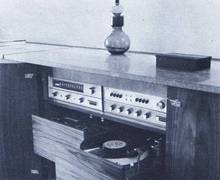
- 4. THE PROFESSIONAL BUILT-IN LOOK: The Fisher TFM-200 FM-Stereo Tuner and Fisher TX-1000 120-watt Stereo Control Amplifier are specialized stereo components designed for the audio connoisseur and professional. A 3-head tape recorder and a professional turntable complement the electronic equipment. These components have been placed in separate drawers that slide out on nylon bearings.
For those who prefer music systems installed in cabinets, there is a wide range of authentically styled designs. The main point to remember is that a cabinet is also a piece of furniture and should be selected to blend with other furnishings.
It is not difficult. Is the room formal or informal? Are the woods of existing pieces light or dark? Try to pick a design which will be compatible in both respects. This is true even in an eclectic interior where many different styles are combined, for it is generally best not to combine pieces which are completely opposite in feeling. A cabinet in Early American styling, for example, will not go well in a room where the other pieces are formal 18th-century.
In rooms which are traditional in styling, there is a wide choice of cabinets. Many traditional designs, although of different origins and periods, go well together. Italian provincial pieces, for example, blend well with French provincial because they both stem from the same basic designs. Oriental and Far East designs are adaptable to both traditional and modern settings.
Another popular style today stems from the Mediterranean area of Spain and Italy. Furniture of this design is characterized by block panel doors, elaborate carving, filigreed woodwork and other motifs derived from traditional Spanish furniture and architecture. It is bold in scale and romantic in mood. There are cabinets available in several variations of this style which many interior designers use to create a striking note of contrast in a modern setting or add architectural and design interest to a traditional room.
Adding a cabinet to a room may mean making a few changes in the existing furniture layout. Seating pieces may require rearranging to take full advantage of the optimum listening area, which means that part of the room where all the effects of stereophonic sound reproduction are heard best. Experiment on paper first by drawing a rough outline of the room. Then measure the major pieces of furniture and place them on the plan. (The best scale to use for this purpose is 1/4" to the foot.)
Try several arrangements and then after you have found the one which looks best on paper, try it in the room. A little effort in trial and error will result in a room arrangement which is not only best functionally but also satisfying esthetically.
Especially prepared for the Fisher Handbook by Sherman R. Emery, Editor, Interior Design.
.
5. HIGH-QUALITY HIGH FIDELITY
The world-famous Fisher 700-T 120-watt FM-Stereo Receiver is the heart of this attractive bookshelf installation which also features two Fisher XP-33 speaker systems. The Fisher 700-T has been universally acclaimed the finest FM-Stereo Receiver ever designed for home use.
.
(6) Herbst 1967 - How High the Hi-Fi Sights (Preis und Leistung)
By Ivan Berger
How much should an audio system cost? The catalogs show a bewildering variety of component prices - speaker systems from $49.95 to $1,170, FM stereo tuners from $84.95 to $750, stereo pickup cartridges from $10.95 to $80, tape recorders from $17 to $2,720, and so on.
The obvious answer: as much as you can (and care to) afford, and, if possible, a trifle over that. For good sound grows on you and your ability to hear it will grow in direct relation to the quality of the system you listen to. The $100 phonograph will sound like "high fidelity" compared to the $29.95 monster in your kids' room; but expose yourself to a $200 sound system and you'll soon be ready to appreciate the superior sound of a $500 component sound setup.
Where does it all end? Does every additional dollar spent on sound make an equally substantial difference in what reaches your ears? No. Once your ear has been trained to high fidelity, the limited range and (what's worse) high distortion of cheaper systems will probably render stereo phonographs costing less than $200 unlistenable to you. A $500 investment should bring excellent sound that even the most golden-eared can at least live with. And anything over $1,000 spent on a phonograph system (less tape or FM) brings convenience, status, and genuinely measurable sound improvements that you probably can't hear.
Speakers should rate first consideration in your budget. With stereo requiring two speakers the old guideline of spending half your budget on them still makes sense, despite the rise in quality of lower-priced speakers. Spending one-third the cost of a phonograph system on its speakers would seem a sensible minimum, since no other component will affect the system's sound to as great a degree.
As to speaker types-bass reflex, acoustic-suspension, electrostatic and the like-each tends to color the sound in a characteristic way. But the better the speaker, the less its coloration; each type can give good sound if properly designed and made.
Your speaker selection should influence your choice of amplifiers. A less efficient speaker calls for a more powerful amplifier. So does a large room, or one with very "dead" acoustics. Fifteen watts (IHF) per channel (30 total) is about the minimum in good quality amplifiers; 70 IHF watts (35 per channel) will suffice for even the least efficient speakers; and power beyond 120 watts or so is significant mainly in terms of a further reduction in already negligible distortion. You may, however, find it necessary to buy more power than you really need to get the best circuits and widest selection of features. Aside from the extra cost, there's no harm done.
Depending on their power, good amplifiers run about $120 to $150 up (and up!), with $250 to $300 a practical ceiling. But many seductive units await the perfectionist at prices well above these figures.
FM tuners should be equipped with a stereo/mono switch, a tuning knob, a station dial, and a meter or "magic eye" tuning indicator (either type does nicely). Other features are again just frosting, though they may appeal effectively to your particular tastes. As to the relative merits of AM/FM versus FM-only tuners, let your listening habits be your guide. If you now listen to your AM radio, by all means include AM in your audio system.
Power amplifiers, tuners, and preamplifier control units can be had as discrete components or variously agglutinated as "integrated amplifiers" (power amp plus preamp) or "receivers" (power amp, preamp, and tuner) on a single chassis. Discrete components cost more but offer greater flexibility in swapping off components as the system grows.
On the other hand, combination units are easier to connect together and operate, and - though only since the advent of transistors - are equally reliable.
The same arguments, of course, hold true for "compact" systems, which combine an integrated amplifier or receiver and a record player in a single unit, with satellite speakers included in the package. The savings are greater, but so are the limitations on your possibly upgrading the system at some future date.
Record players are either manual or automatic and units of high quality are found in both camps. Manual tables are simpler and good ones are therefore less expensive and potentially more reliable than good automatics. Against this, automatic enthusiasts balance the convenience of automatic shutoff at the record's end and the delicate precision of a tone arm that settles untouched by human hands into the lead-in groove.
Expect to pay at least $90 for a good automatic, and at least $50 (better yet, $75) for a good manual turntable with arm. Unless you are both precise and handy, avoid tonearms which you must mount on the turntable yourself.
The pickup cartridge, though the smallest component, is not the least significant. Good cartridges are available for as little as $10 or so, with the very best ones costing between about $50 and $80 - but you'll probably get the most for each dollar spent in the $20 to $40 range.
That leaves only tape recorders to puzzle one - but they're complex enough to rate an article of their own.
Condensed from Saturday Review. Copyright by Saturday Review, Inc.
(7) Solid State Stereo (Halbleiter in der modernen Technik)
Herbst 1967 - By Leonard Feldman
Within the broad category of stereo electronics there are three basic approaches to equipment selection. Taking them in increasing order of complexity: first is a system built around an "all-in-one" or tuner/amplifier or, simply, a receiver. By far the best seller on today's market, a stereo receiver contains the elements found separately in the other two approaches to system assembly. A tuner section (either FM/stereo or AM and FM/stereo) is combined with a preamplifier and power amplifier on one fairly compact chassis. Speakers are connected to its output, and enough signal jacks are provided to permit connecting a record player (automatic changer or a single play turntable and tone arm), a tape recorder, almost always a stereo headphone set, and, in some models, even microphones or the sound portion of a TV receiver. In short, the stereo receiver contains in one unit all the electronics you might need for a first-class stereophonic sound installation.
Why it has taken nearly ten years for this simplified approach to gain ascendancy over its more complex, elaborate rivals has to do primarily with the development of economical, high performance solid-state, or transistorized, equipment. Time was when an integrated receiver of reasonable power output capabilities was a massive device employing several tubes and massive output transformers - devices which took up a great deal of space on a chassis and which also produced a lot of heat. Tube heat, in fact, has been the anathema of electronic component longevity, discouraging many manufacturers from attempting to crowd all the necessary electronic elements onto one chassis. Those who produced all-in-one receivers were limited to low-power-output receivers.
Properly designed solid-state receivers changed all this. Much more compact than tubes and producing far less heat, transistors facilitated receivers of practical dimensions, ample power output, and reliable life-span. Moreover, transistors did away with the need for bulky output transformers. So rapid has been the transition to solid-state that today very few tube-type receivers are available. Those that are still produced fill a need for "budget" systems, for it is a fact of the new solid-state world that the cost of a transistorized receiver of given performance is still somewhat higher than its vacuum tube equivalent.
This cost differential, however, is rapidly vanishing. In my opinion, when evaluated in the light of reliability, no tubes to replace, compactness, and general convenience of installation, whatever cost differences still prevail are fairly well offset.
If the "complete receiver" is so desirable, one might well wonder why alternate choices continue to exist. The answer must be found in a rule of fewer units of higher quality appealing to a relatively smaller audience, and at higher cost. This rule is true of all products-from wrist watches to automobiles. In audio it often has been stated that the first three hundred dollars spent on high fidelity gear will render the greatest measure of audible improvement over the table model or "low-fi" radio or phonograph. The next seven hundred dollars or more, goes the canard, will result in barely discernible improvement in sound quality for most listeners. Nevertheless, as more and more buyers come to appreciate high quality sound in the home, the number of listeners able to detect this last measure of performance must be increasing as well.
Then, too, an initial investment of, say, three hundred dollars on a preamplifier-amplifier (omitting FM radio, at the outset) is bound to result in higher quality (or higher power output, for the person who plans to have many speaker systems in various rooms all fed from the same electronics, for example) than one could obtain if the same investment were made in an all-in-one receiver. Many stereo buyers, therefore, elect to purchase their preamplifier-amplifiers first. Then, at some later date, they will purchase a very high quality separate tuner, gradually assemblying their system in more or less piecemeal fashion.
Carrying this approach a step further brings us to the third alternative, that of a separate power amplifier, a separate preamplifier, and a separate tuner. This type of system has an appeal to the all-out perfectionist who can select the elements from among the very best separates currently available or at least from those separates that offer unique features-such as the highest possible amplifier power, or the last word in control versatility.
From an installation standpoint, the completely separate unit approach is a mixed blessing: you are dealing obviously with more individual product units for a given system, and so you must be prepared to devote more over-all space to the installation - but the very separateness of these units permits a great latitude in their arrangement.
For instance, the large power amp can be tucked out of sight, while only the preamp-control panel is exposed. Often, the tuner (if purchased from the same manufacturer) has a matching front panel for a unitized and attractive appearance, whether the components are installed side by side or one above the other. Finally, the completely separate approach lets you buy the very latest and best piecemeal, as your budget permits. It also lets you substitute new units for older ones so that your system will always reflect "state of the art" electronic design, if such is your inclination. The separates you have replaced then can be traded or sold-there is a lively market for good used equipment.
Condensed from Stereo Copyright by the Billboard Publishing Company.
.
(8) The Long and Short of Short Wave (Kurzwellen-Radio)
Herbst 1967 - By Roland Gelatt
The short wave band is beginning to appear on high fidelity tuners - and that's a pretty weird thing, because nothing could be further from the sound of high fidelity than a short wave broadcast. What you're apt to encounter here is so fascinatingly different from anything on domestic AM or FM that you'll willingly settle for lower sonic quality.
Unlike radio waves in the broadcast and FM bands, those in the short wave spectrum can hop over great distances. This is because short waves are reflected back to earth by the electrified part of the upper atmosphere - a region called the ionosphere, about 100 miles up in the sky.
At least nine times out of ten, London or Moscow can be tuned in as easily and clearly as your local station. And when they sound too faint and fluttery for pleasurable listening, there are still plenty of other stations to be heard.
Most short wave broadcasts are specifically programmed for listeners abroad, and they fall into two over-all categories: those aimed at nationals of the transmitting country (people who are either living or traveling overseas) and those aimed at nationals of the receiving country.
.
For Stateside listeners the most consistently enjoyable fare comes from London. The BBC World Service broadcasts almost around the clock on several different wavelengths; and although it comes in strongest during the late afternoon and evening, when transmissions are beamed directly to North America, you can usually pick up the World Service at any time. News broadcasts are scheduled fifteen times a day on the hour, and they're excellent - not only for their measured reporting of international events but also for their coverage of British and Commonwealth affairs.
In addition to straight news broadcasts, the World Service has several "magazines of the air" - Radio Newsreel, The World Today, Science and Industry, London Forum - all well produced and informative. Musical fare takes the form of orchestral concerts and solo recitals (usually derived from the BBC's home services) and of commentary by various London critics. You can hear HIGH FIDELITY'S Edward Greenfield discuss the latest British record releases in a weekly potpourri show called Outlook.
.
A few short wave transmissions allow the overseas listener to eavesdrop directly on a country's domestic programs, and for me these provide the most engrossing fare of all. Here you'll encounter nothing tailored for export. What you hear over your loudspeaker is the real McCoy - a short wave pickup of a program being broadcast simultaneously to home listeners thousands of miles away.
For instance, Radio Moscow short waves its "second network" program (known as "Mayak"), which comes in strong on the East coast of North America from mid-morning until late afternoon. "Mayak" is a light program with news on the hour and commentary or interviews on the half-hour, interspersed with music. It takes a good Russian linguist to pick out more than the obvious proper names in the announcements (to say nothing of the news broadcasts), but that's enough to let you know that it's Vishnevskaya singing Rachmaninoff.
Other opportunities for eavesdropping On domestic programs are offered by the ORTF in Paris, which relays on short wave a few hours of France-Inter - another news-and-music affair, good for desultory listening and brushing up your French; by Norsk Rikskringkasting, which broadcasts an hour and a half of the home service for the benefit of nostalgic Norwegians abroad; and by the Swiss Broadcasting Corporation, whose 250-kilowatt transmitters at Schwarzenburg relay portions of the home programs in German, French, and Italian.
Australia and China (Peking variety) have extensive short wave schedules; plenty of Latin American cha-cha and rhumbas emanate from transmitters south of the border; and there are some English-language evangelical stations in such unlikely places as Ecuador and Bonaire (in the Netherlands Antilles).
Finally, a word about equipment. As mentioned at the outset, the short wave band is now showing up on a few component tuners and receivers. The advantages of having short wave incorporated in a piece of well-engineered and well-styled componentry are obvious.
And even if the fidelity is low, there's high delight at having the world at your fingertips.
Condensed from High Fidelity. Copyright by the Billboard Publishing Company.
.

